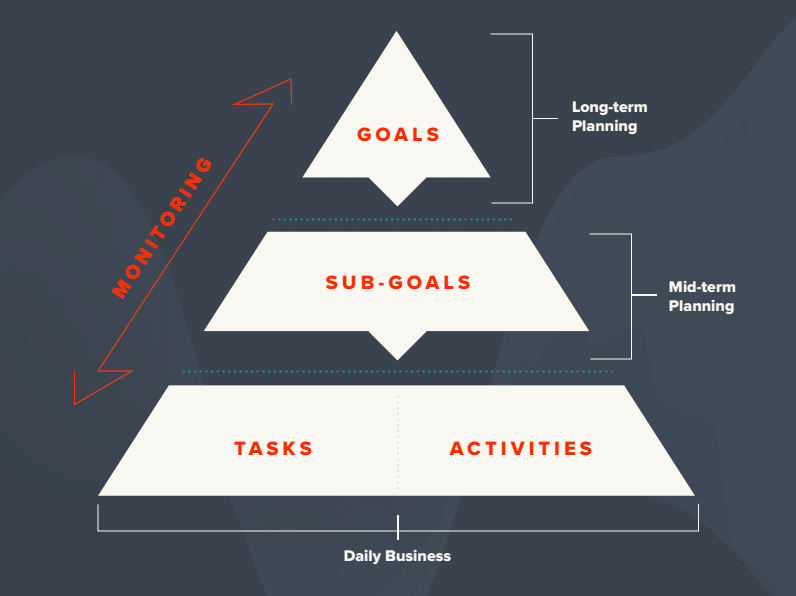The Hierarchy of Business Goals
Trying to figure out how to make those big business goals reachable? Try the Hierarchy of Goals— it might seem a little familiar already.
July 12th, 2017 | By: Emma McGowan | Tags: Strategy
You’ve probably heard of Maslow’s Hierarchy of Needs, right? Just in case you’ve been living under a rock — here is a quick recap:
In 1943, a psychologist named Abraham Maslow proposed that humans have a five “levels” of needs, usually drawn in the shape of a pyramid.

The needs at the bottom of the pyramid are physiological needs that are necessary for survival: food, water, warmth, rest.
The next level up is “safety,” followed by “belongingness and love,” then “esteem,” and, at the very top of the pyramid, “self-actualization.” The basic idea is that humans need to meet those basic needs first, before they can be concerned about the needs further up the pyramid.
Makes sense, right? You can’t really think about transcendence when your stomach is growling.
Well, Lifehacker took that idea and came up with a Hierarchy of Goals. It’s a great reworking of an old-school idea for the new-school world of startups.
So how does it work?
Level 1: Primary goals
For this business goal template, you’re going to draw a pyramid with five different levels. The bottom of the Hierarchy of Goals is the biggest level and also the biggest goal. This is where you’re going to put your big, big picture stuff or, as writer Thorin Klosowski says, your goals that will matter in 20 years. In order to determine what these Primary Business Goals are, ask yourself:
- What’s the most important thing I want to do with my life?
- If there were no restrictions —not money, not time, nothing — what would I want to accomplish?
- What do I want to think about on my deathbed?

Level 2: Long Term Goals
The second level of the Hierarchy of Goals is your Long Term Business Goals. These are a little less lofty and a little more based in reality than your Primary Goals. They’re the things you’ll need to work on for years and years if you’re going to meet that big, lofty, Primary Goal. So, ask yourself:
- What’s a sustainable habit that I can keep up every year for the rest of my life?
- What’s a concrete outcome that I can work toward over a long period of time?
Level 3: Short term goals
The third level up is your Short Term Business Goals. While your Long Term Goals won’t be reached for years, your Short Term Goals should be achievable in months, or even weeks. They’re the fuel that’s going to keep you going as you work toward those really big Primary and Long Term Goals, because they give you “little” (and sometimes not so little) wins along the way. Ask yourself:
- What small steps can take in the next month toward my big goal?
- What steps can I take in the next week?
- What steps can I take right now?

Level 4: Recurring Goals
The next level of the Hierarchy of Goals is your Recurring Business Goals. These are your habit-forming business goals — the things you’re going to do every day or week or month — and they’re the baby steps to your Primary and Long Term goals. Ask yourself:
- What habits do you need to form in order to meet your big goals?
- What are the specific actions you need to take to form those habits?
- How often can you realistically take those actions?

Level 5: Immediate Goals
Finally, the very top of the Hierarchy of Goals is Immediate Business Goals. These are things you can do right now. You can include both steps to help you reach your goals and other stuff that you just have to do because: life. Think “answer 10 emails,” or “clean the kitchen.” Both are going to help you get where you need to go. So, ask yourself:
- What can I do right now?
- What do I need to do right now?
- What “life” things do I need to make sure don’t fall by the wayside?
Once you’ve filled everything out, Klosowski says the next step is to “trim the fat” — i.e. get rid of anything that you don’t actually need to do — and turn it into an actionable plan. It’s a great method for people who are both logical and visual.
And if you think maybe it’s not quite right? Be sure to check back tomorrow and later this week, when we’ll be taking a deep dive into other business goals templates, including Visual Mapping and S.M.A.R.T. goals.
About the Author
Emma McGowan
Emma McGowan is a full time blogger and digital nomad has been writing about startups, living with startup people, and basically breathing startups for the past five years. Emma is a regular contributor to Bustle, Startups.com, KillerStartups, and MiKandi. Her byline can also be found on Mashable, The Daily Dot's The Kernel, Mic, The Bold Italic, as well as a number of startup blogs.
Follow her on Twitter @MissEmmaMcG.
Related Articles
Unlock Startups Unlimited
Access 20,000+ Startup Experts, 650+ masterclass videos, 1,000+ in-depth guides, and all the software tools you need to launch and grow quickly.
Already a member? Sign in